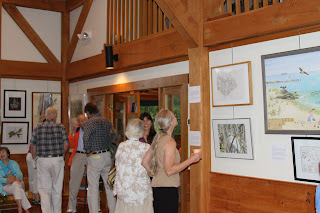Highstead collaborates with the Guild of Natural Science Illustrators' Greater New York chapter to showcase artwork on the theme of "Habitats, flora & fauna in natural settings".
Background:
Highstead is a 150-acre preserve/arboretum/research area in Redding, Connecticut.
The Guild of Natural Science Illustrators (GNSI) is a 1000-member society of artists working in the field of, well, depicting natural science through works of art.
 |
| Browsing the "Habitats" exhibit on opening day. |
This morning, Saturday, September 8, 2012, nearly fifty people gathered at Highstead for the opening reception of the art show and a conservation presentation that followed. Guild members exhibited drawings and paintings on the theme of Habitats. With such a broad topic, the pieces were bound to be diverse, and they were.
 |
| attendees intently studying the artwork and accompanying texts |
 |
| Dorie Petrochko talking about her Milford Harbor painting. |
 |
| Me describing the unique habitat of the Red-cockaded Woodpecker. |
http://www.gnsi.org/




